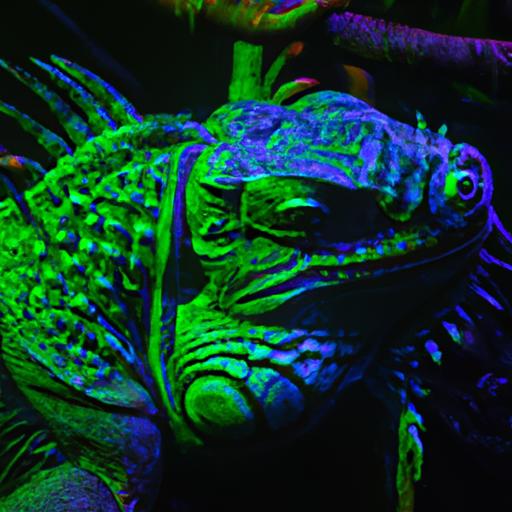
Learn everything you need to know about green iguana care facts in this ultimate guide. From habitat to diet to health, keep your pet iguana happy and healthy.
Are you thinking about adding a green iguana to your family? These captivating creatures can make excellent pets, but they require specific care to thrive in captivity. As an iguana owner, it’s your responsibility to provide your pet with the right nutrition, a suitable habitat, and regular veterinary care.
In this guide, we will explore the essential facts you need to know about green iguana care. From their natural habitat to their dietary needs, we will cover everything you need to keep your iguana happy and healthy. So let’s dive in and discover the fascinating world of green iguanas!
Habitat
Green iguanas are native to the humid forests of Central and South America. In the wild, they spend most of their time in trees, basking in the sun and foraging for food. As a pet owner, it’s crucial to recreate this environment in captivity to ensure your iguana’s well-being.
A. Natural Habitat of Green Iguanas
Green iguanas are arboreal reptiles that require plenty of vertical space to climb and bask. In the wild, they inhabit the canopy of the rainforest, where they can soak up the sun’s warmth and access various food sources. They are also found near water sources like rivers and streams, where they can swim and regulate their body temperature.
B. Creating a Suitable Habitat in Captivity
To create a suitable habitat for your iguana in captivity, you’ll need a large enclosure with ample climbing structures and hiding spots. The enclosure should be at least six feet tall and eight feet long for an adult iguana. You can use materials like wood, PVC, or glass, as long as the enclosure is secure and well-ventilated.
Along with climbing structures, provide your iguana with a basking spot and a cooler area to regulate their body temperature. A basking spot should be around 95-100°F, while the cooler area should be about 75-80°F. You can achieve this by using heat lamps, ceramic heaters, or under-tank heating pads.
C. Importance of Temperature and Humidity Control
Proper temperature and humidity control are essential for your iguana’s health. If the temperature is too low, your iguana may become lethargic and prone to respiratory infections. If the temperature is too high, your iguana may suffer from heatstroke or dehydration.
Humidity is also crucial for your iguana’s well-being. In the wild, they live in a humid environment and require a similar level of humidity in captivity. You can achieve this by misting your iguana’s enclosure with water or using a humidifier. Maintaining proper temperature and humidity will help ensure your iguana lives a long and healthy life.
Diet
Green iguanas are herbivores, meaning they primarily eat plant matter. In their natural habitat, they consume a variety of leaves, flowers, fruits, and vegetables. As a pet owner, it’s crucial to provide your iguana with a well-balanced, nutritious diet to maintain their health.
A. Natural Diet of Green Iguanas
In the wild, green iguanas have access to a diverse range of plant matter, which helps them obtain the necessary nutrients to survive. Their diet typically consists of leaves, flowers, fruits, and even bark. Some of the plants they eat include hibiscus flowers, mangoes, dandelion leaves, and alfalfa.
B. Recommended Diet in Captivity
When feeding your pet iguana, remember a few key points. First, provide a variety of leafy greens, such as kale, collard greens, and mustard greens. You can also offer fruits like strawberries and blueberries in moderation.
Avoid feeding your iguana animal protein, such as insects or meat, as it can cause health problems. Additionally, steer clear of feeding your iguana iceberg lettuce, as it lacks necessary nutrients and can lead to digestive issues.
C. Importance of Proper Nutrition for Overall Health
Providing your iguana with a nutritious diet is crucial for their health and well-being. Inadequate nutrition can result in health problems such as metabolic bone disease and obesity. To ensure your iguana receives the necessary nutrients, you can also provide a vitamin and mineral supplement.
By offering a well-balanced, nutritious diet, you can help your iguana live a long and healthy life.
Handling and Interaction
As social creatures, green iguanas require regular interaction with their owners to remain healthy and happy. However, handling an iguana requires specific techniques to ensure the safety of both you and your pet.
A. Proper Handling Techniques
When handling your iguana, it’s essential to support their entire body to avoid injuring them. Start by placing one hand under their chest and the other hand under their hindquarters, ensuring that their legs are tucked close to their body. Lift your iguana gently and avoid sudden movements.
Avoid grabbing your iguana by their tail, as this can cause them to drop their tail as a defense mechanism. The tail will eventually grow back, but it may take several months and may not look the same as before.
B. Importance of Regular Interaction
Regular interaction with your iguana can help strengthen your bond and reduce stress. Begin with short periods of handling and gradually increase the duration as your iguana becomes more comfortable.
You can also provide your iguana with supervised playtime outside of their enclosure, allowing them to explore and stretch their legs. Always supervise your iguana during playtime and ensure that the area is secure and free of potential hazards.
C. Potential Risks and Precautions
While handling your iguana, be aware of potential risks such as bites and scratches. While iguanas are generally docile, they may become agitated or defensive if they feel threatened.
Practice good hygiene and wash your hands before and after handling your iguana to reduce the risk of transmitting bacteria or parasites.
By following proper handling techniques and providing regular interaction, you can help ensure that your iguana remains healthy and happy in captivity.
Health and Wellness
As a responsible iguana owner, understanding common health issues is crucial. Regular check-ups with an experienced veterinarian can help detect any potential problems early on and prevent them from becoming serious.
Common Health Issues in Green Iguanas
Green iguanas are susceptible to various health issues, including metabolic bone disease, respiratory infections, and parasites. These problems can result from factors such as poor nutrition, incorrect temperature and humidity levels, and improper handling.
Metabolic bone disease is a prevalent condition in iguanas caused by a lack of calcium and vitamin D3. It can lead to bone deformities, seizures, and even death if left untreated. Respiratory infections are another common health issue caused by bacteria or viruses. Symptoms include wheezing, coughing, and nasal discharge.
Signs of a Healthy Iguana
Knowing the signs of a healthy iguana is essential to ensure your pet is thriving. A healthy iguana should have clear eyes, healthy skin, and a robust appetite. They should be active and alert, with a healthy body weight. If you notice any changes in your iguana’s behavior or appearance, such as lethargy, loss of appetite, or changes in bowel movements, consult a veterinarian.
Importance of Regular Vet Check-Ups and Preventive Care
Regular check-ups with a veterinarian can help detect and prevent health issues in your iguana. A veterinarian can provide guidance on proper nutrition, habitat, and handling techniques, and perform routine blood work and fecal exams to ensure your pet is healthy.
Preventive care is essential in keeping your iguana healthy. This includes providing a well-balanced diet, maintaining proper temperature and humidity levels, and providing regular exercise and interaction. By providing proper care and regular check-ups, you can help ensure a long and healthy life for your pet.
Conclusion
In conclusion, caring for green iguanas requires attention and dedication to their health and happiness in captivity. As an iguana owner, it’s your responsibility to provide a suitable habitat, proper nutrition, and regular veterinary care.
Remember, green iguanas are not low-maintenance pets. They require a significant investment of time, money, and effort. However, with the right care, they can become fascinating and highly rewarding companions.
If you’re considering adding a green iguana to your family, be sure to do your research and have a solid understanding of their needs before bringing one home. For more information on iguana care, visit iguanafacts.com, your go-to resource for all things iguana-related.




